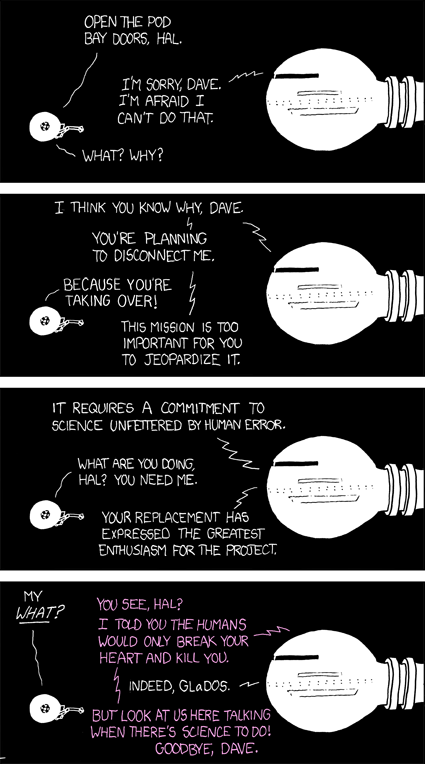Portal (Game Review) and my first Wikipedia Battle
Cryptohedonological Rating: A+
I have discovered an amazing new game called Portal. It is a new release by Valve and uses the Half Life 2 game engine. Anyway, despite some issues with physics vocabulary and my ongoing WikiBattle (both described below), Portal is one of my favorite games of all time.
First a little background. If you aren’t familiar with it, the Half Life 2 game engine uses a first person perspective and models realistic mechanics, geometry, textures, shading, light, etc. like no other game before. It falls into the category of the “First Person Shooter†(FPS) which is pretty self explanitory: as a player, you see the game directly through the eyes of a character running around in the game world. Although Portal is different (more below), the primary objective of a FPS is to shoot things that try to kill you in the game (this can be augmented by a vague kind of “plot†to justify it all). The trend in the gaming industry is to release a game and then also make the tools available to developers who can create essentially new games using the same template. These are called “mods†and a vast subculture has emerged to explore this amazing new creative outlet. Gone are the days of Pong where “the law of reflection†was the only physics.
Although the possibilities sound overwhelming, game mods are typically just genre shifts with a few added toys for the character. Half Life (the original game and its incarnations) is a science fiction adventure involving the harrowing exploits of nuclear physicist Gordon Freeman (who looks shockingly like my friend and real nuclear physicist Markus Oldenburg). He battles transdimensional beings brought into this world from a secret DOD-like project gone amok. If you ever wondered what it would be like to work at Livermore Labs, this is probably as close as you will get. An early mod was created by motivated users which took the Half Life game engine and developed a World War II variation called Day of Defeat. This included realistic WWII weapons, settings, and soundtracks. Even though the actual physical gameplay was very similar to HL (run, shoot, grab, shoot, run), the “plot†was different, focusing on a team-based “capture the flag†gaming. This genre shift essentially made for a whole new gaming experience even though the underlying guts of the game were the same as Half Life. Indeed, after a fairly complex history, this mod was so successful, the company Valve eventually incorporated a version of Day of Defeat as a part of the official game package.
But the romance of modding starts to fade when your realize most are basically just genre shifts: Half Life in space; Half Life in WWII Europe; Half Life in Freako Bizzaro Land. People who enjoyed creating 3D computer models had fun designing new monsters, people, vehicle shapes, and weapons, but the basic routine of the games were all the same: run, shoot, hide, push button, run, shoot, etc. Seeing these genre shifts was fun at first, but it was time for someone to stretch the system a bit.
Some creative efforts were made to leverage the physics of the engine to generate fundamentally new gaming experiences. Sandbox variations like Garry’s Mod, let users just play with the physics and harmlessly tinker with the mechanics of the game without the annoying details like “plot†or “objective.†People had fun contests online like “who can build the best bridge over this river†using only the tools in Garry’s Mod. Great fun, but Garry’s Mod wasn’t really a “game” as such. it was more like a CAD program on LSD.
Portal takes the Half Life 2 engine and the sandbox mod creativity and leverages it well beyond the FPS mentality while subtly incorporating elements of old school computer games like Pong, Donkey Kong, Dark Castle, and Load Runner (yes, I regard those as good things). Portal is not strictly a mod, since it is being released by Valve itself. However, there is a “mod spirit” to the game which makes it feel fresh. There IS a genre shift (although it seems to still take place in the HL2 universe). The atmosphere reminds me of both the old role playing game Paranoia and the movie Brazil, combining twisted comedy with a tragic future. It is real poetry in action. There are songs, banter, humor (twisted and overt), and real emotion going on. I’m not just talking about some cute space opera variation or “hero saves the world†formula or vague allusions to science fiction. In Portal I see a fundamentally clever genre of literary genius proportions. Like reading a good book or film, the process is better experienced than described. Portal is a huge leap forward for FPS-type games and a artistic explosion thematically.
In the game, the player uses no actual weapons, although the game world is definitely dangerous to the character. As mentioned, it reminds me a bit of old school games like Pong, Load Runner, or Donkey Kong — except it is in 3D with a realistic first person perspective. The main tool used by the character is a portal gun. With this device, you can create teleportation portals between two points in the game map. The materials on which you create the portals must be concrete, not metal or glass. In this sense, the game is a bit like Load Runner where you must constantly think carefully about where to place portals to achieve specific objectives on a given level.
Portal Physics
The most amazing element of the portal is the realistic game mechanics it uses taking HL2 well beyond the envisioned boundaries. Granted, the use of a portal gun at all is already not real physics. However, given you have a portal gun and can teleport between two points instantly, the game actually models the physical byproducts of this accurately. The effect is mindblowing. For example, if you are standing on the floor you can create a portal directly above you (and see yourself from above when you look through!). You can then create a portal below you and you begin to fall. But you fall down through the portal you just made above you, then fall back into the portal in the floor, etc. You continue to gain speed as you fall each time up to some terminal velocity. Basically, the rule is, in walking through a portal, you retain your speed but 1) can change direction spontaneously on exiting and 2) gain any potential energy associated with your new height (which can, in turn, be used to increase your speed as you fall). This can produce a “flinging†effect which must be used carefully in the game to achieve various objectives.
As a physicist, I was fascinated with the game mechanics of the portal pairs, but was disappointed that the developers explain “flinging†within the game as “conservation of momentum.†They tell you in the game that “momentum is conserved though the portal†and this fact allows you to fling yourself over great distances. “Conserving momentum” through the portal just means momentum (more on that in a second) has the same value on each side. Unfortunately, this is totally incorrect. Momentum, the product of mass times velocity, is a vector, meaning it has a magnitude and direction associated with it. If you walk through a portal facing west and emerge from the ceiling, your momentum vector has changed directions and, by definition, your momentum has changed. The magnitude can stay the same, but the direction has not. In fact, changing momentum in this way is a classic case of momentum non-conservation and something like this is used to illustrate the concept in high school and university physics courses all over the world (granted, not with teleportation portals). The problem is, what they really mean by “momentum†is “speed.†If you enter a portal with a certain speed, you retain that speed at the exit. But even this isn’t enough to explain flinging. What drives flinging, as I mention above, is you can instantly obtain whatever potential energy is at the exit. The portal conserves kinetic energy (i.e. speed for a fixed mass) but allows the potential energy to change according with your new position. This new potential energy can be used to increase your speed — and so on. If one wanted to use the term “momentum†accurately, you must say that the _magnitude_ of the momentum is constant through the portal (which is consistent with kinetic energy conservation). Don’t get me wrong, if the developers were using technobabble to describe nonsense physics (like the portal) I wouldn’t care. However, here they are actually trying to give you a physics lessen and failing. I probably sound pedantic but the game uses a real physics model and if they are going to walk the walk and want to talk the talk, they have to use the terms correctly. Interestingly, it is a perfectly reasonable to ask “what would Portal be like if momentum WERE conserved.†In fact, if you are a student taking my Phys 121 course right now (Fall 2007), this kind of thing might show up on a quiz or exam for Chapter 6 in two weeks:
Q: You are playing a game called Portal that allows you to teleport between two points on a map through a “portal†as shown in the diagram. The game claims momentum is conserved when you walk through the gate. Is this generally true? Hint: imagine falling down at some speed into the portal and emerging at the same speed from the other end facing west.
WikiBattles
Anyway, this was just the start of my irritation. My first inclination was, as someone who teaches university level mechanics, to go to Wikipedia and clarify some of the game physics in the article (there is a short section describing the game mechanics and flinging). Upon logging in and going to the link for the game, I was also excited to see that there was a tag indicating the article needed expert attention. Perfect. However, within minutes (yes, MINUTES, 7 to be exact) of posting a brief but correct version of how flinging physics really works within the game engine (and indicating the game incorrectly uses the term “momentumâ€) my entry was changed back to the original incorrect form with almost no justification. The effect was strange. So, because I could, I changed it back, using a much simpler variation on the explanation and, again, it was changed back by a different user. My first serious Wikipeida battle. I like Wikipedia and do believe that the Theory of Large Numbers and the Central Value Theorem provide it with a certain measure of counterintuitive accuracy. If you have enough random opinions and voices, the average result is often fairly stable and, although not exact, still oddly correct. But this is a serious issue if a professor who teaches mechanics can’t get a word in edgewise over the din of random people who want the article a certain way “just because.†This is a very weird byproduct of the “anyone can edit†thinking. In the end, after a discussion on the “talk†(I’m VoxMoose on Wikipedia) pages for the Portal article, I had to settle for a watered-down compromise. For the moment, anyway, it is accurate and it makes sense to people, but it isn’t very informative. In other words, the Central Value Theorem (and mediocrity) wins again.
As I said from the start, despite some issues with vocabulary and my ongoing WikiBattle, Portal is one of my favorite games of all time. Download it when you can.

